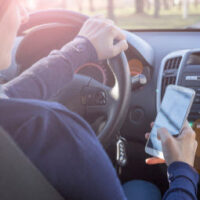How Multitasking Leads to Dangerous Driving

In recent years, the need to multitask has become almost universal, regardless of a person’s employment situation or personal life. For instance, many of us are expected to answer emails, while also taking a lunch break, and answering any work-related phone calls. While multitasking can be accomplished in a safe manner, it is not always appropriate, especially while driving. This is because, while many of us pride ourselves on our ability to multitask, the human brain is not actually well-equipped to give our full attention to two or more tasks at the same time. In fact, government studies have revealed that when it comes to driving, even adding one more task, such as listening to the radio, reduces the amount of brain bandwidth that is actually dedicated to driving by almost 40 percent.
Unfortunately, even those of us who take great pains not to multitask while driving, can sustain serious injuries in accidents caused by other distracted drivers, so if you were injured in a collision with a distracted driver, please contact an experienced car accident attorney who can explain your legal options.
Multitasking and Distracted Driving
It’s one thing to try and multitask while sitting at a desk in your office and quite another to try and answer emails or respond to text messages while driving. Drivers who participate in these types of activities place not only themselves, but also anyone else on the road at risk of serious injury. This kind of behavior has become of increasing concern in recent years, with the Centers for Disease Control and Prevention (CDC) even estimating that around nine people lose their lives every day in accidents caused by a distracted driver, while a further 1,000 sustain injuries.
While most people associate distracted driving with phone use, the reality is that a wide range of activities, if conducted while driving, qualify as distractions, including:
- Eating or drinking;
- Adjusting controls;
- Reaching for something in the back seat;
- Looking in the mirror for grooming purposes;
- Checking a GPS; and
- Smoking.
Even talking to a passenger, listening to music, and daydreaming can qualify as distractions if they take a driver’s hands, eyes, or mind off of the road. Depending on a driver’s speed, these types of activities can cause a driver to travel a long distance without looking at the road in just a short amount of time. In fact, it is estimated that a driver who is traveling at 55 miles per hour travels the length of a football field while reading a text message for only five seconds.
Preventive Measures
Because distracted driving is so dangerous, it is important for drivers to take all necessary precautions to ensure that they don’t engage in this type of behavior. For instance, drivers who absolutely must talk on the phone or answer a text should pull over to the side of the road and should refrain from doing so at intersections, where some of the most serious distracted driving-related accidents occur. Drivers are also encouraged to focus on one thing at a time, which is also known as single-tasking. Although it may seem to take up more time than if a person multitasked, single-tasking actually allows people to focus entirely on one task and so complete it both faster and more accurately.
Call Today to Speak with an Experienced Car Accident Attorney
If you were injured in an accident with a distracted driver, you could be eligible for compensation. Please contact our Fort Lauderdale legal team at Boone & Davis by calling 954-566-9919 to learn more.
Resource:
ncbi.nlm.nih.gov/pmc/articles/PMC2713933/
